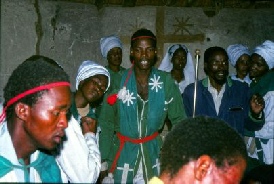© 2023 Dr Margaret Sheppard
A fairly typical weekly service is one that was held at Episcopal on a Sunday. Not everyone arrived promptly at 9.00 a.m. when the service was due to start. Before everyone entered they removed their shoes and left them outside the rondavel church. Members were dressed in their uniforms. The service started with singing of Zion hymns, accompanied by two drums. Anyone could start a hymn although the church choir led the singing if necessary. There were some Bible readings.
As late comers arrived everyone stood up and sang a welcoming hymn. Late comers, especially those holding church offices, often started a hymn outside and then this would be taken up by the congregation inside. The entrant would bow down in respect, and move to their correct place.
The Khosa made sure that people stood in the right place -
Before the service started properly there is usually a time for confession. At two churches this was the time when every member in turn knelt down and prayed aloud, asking forgiveness for individual sins and/or for special prayers for a particular personal problem or individual. At the other churches everyone faced in one direction or outwards towards the walls and prayed aloud simultaneously their own prayer or confessions. This would gradually subside into the Lord's Prayer, then everyone would rise to their feet and start singing. From this point hymns would be accompanied by dancing.
The Secretary would be called upon by the various Baruti to read an appropriate part of the Bible (either on a particular theme on which he wanted to preach, or for the time of the year). Each Moruti would be given a chance to expound on his particular chosen Bible reading. These sermons would be interspersed with hymn singing and dancing.
Members dance to the hymn, usually around a candle placed in the middle of the floor, they dance in a line following the lead of a senior member. In the church services I attended, men, women and children danced. As the dancing became
more spirited the dancers twirled around, hissing like snakes and might even jump up in the air. (However sometimes at
special services held to find the cause of particular problems, only the more experienced prophets danced.)
Whilst dancing, a member with prophetic powers may "get the Spirit" and then the dancing is stopped and the prophet(s) reveal any prophecy(ies). These may be for individual members, present or not present, requiring special protections, or even about non-
If members of the congregation (or even non-



Episcopal Church built in the yard of the Bishop. The homemade cement bricks are made by members who are aiming to replace their traditionally built mud and cattle dung rondavel church with a more substantial building
The church was in a rondavel. Members leave their shoes outside the door before entering





Drums accompany the singing
The Bishop and Baruti of Episcopal
Prophets dancing around a member whilst congregation sing hymns to “call” the Holy Spirit to enable them to prophesy the member
Inside Episcopal’s Church





Kanana (God is Love) Church Choir
Bethlehem Vice Bishop and a Prophet preaching from the platform
Member sitting in centre of dance circle awaiting Prophets to receive the Holy Spirit and prophesy her following the hymns and dancing



Zion Church members use Holy Water for protection and healing not traditional medicines. At this Sunday service at Bethlehem the Vice Bishop and Priests are blessing members ‘ bottle of water to render it Holy whilst others members sing hymns and dance around them. The Holy Water is used by Zion Church members not only as protection against ill-




Vice Bishop and Priests/Praying on congregation -
Regular Services
After this part of the service, there is often a time when the Baruti, especially the Barapedi (Prayers), pray on the congregation. The Barapedi enter the dance circle and stand in the centre. The dancing and singing helps them to have power from the Spirit to pray on people. People who have asked for special prayers and prophecies are often prayed for first. They kneel in front of the Morapedi and he places his hands on them -
Following this there is usually a time for offertory. A bench may be placed in the middle of the dance circle -
Services are long, many I attended ended at sunset, although I had been told they should end by 2.00 p.m.
In addition to these regular services are the Special Services, some of which are held at the church and others at a member’s home. Details of these special services are outlined in other sub sections.